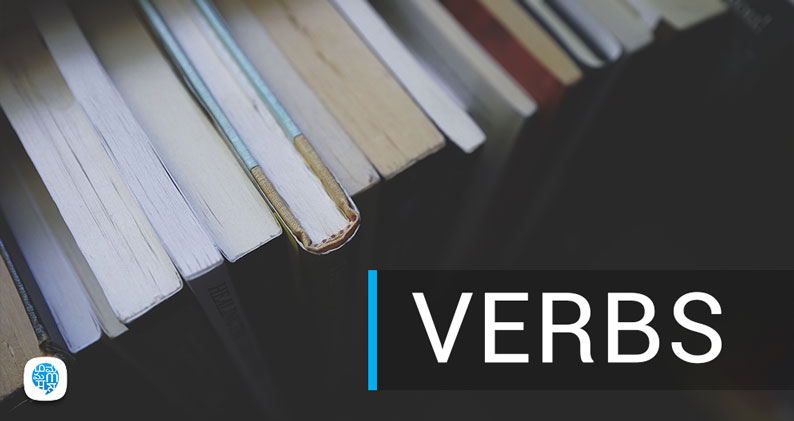வரையறை மற்றும் பொருள்
ஆங்கில இலக்கணத்தில் பேச்சு வார்த்தைகளில் ஒன்றே ஒரு வினைசொல்.
வினைச்சொற்கள் அடிப்படையில் தூங்குதல், சாப்பிடுவது, சிரித்தல், எழுதுதல் போன்றவை போன்ற செயல்களை விவரிக்கின்றன.
இந்த நடவடிக்கைகள் மூன்று வடிவங்களில் வெளிப்படுத்தப்படுகின்றன.
-
முதலாவதாக, நீச்சல், வாசித்தல், நடத்தல் போன்றவை போன்ற செயல்களைச் செய்கிறோம். -
இரண்டாவதாக, நாம் கற்பனை செய்ய நினைக்கும் மனோபாவங்கள், சிந்திக்க வேண்டும் போன்றவை. -
மூன்றாவதாக, இருப்பது நிலை தொடர்புடைய நடவடிக்கைகள் like is, are ,was, were, etc.எடுத்துக்காட்டுகள்
| Sentence | Verb | Explanation |
| Om went to music class. | Went |
இங்கே வினை "சென்றது" நடவடிக்கை "போ" என்று விவரிக்கிறது.
|
| Meera guessed correctly | Guessed |
இங்கே, வினை "யூகிக்க" செயலை விவரிக்கிறது.
|
| It was an accident. | Was |
இங்கே, வினைச்சொல் "இருப்பது" என்ற நிலையில் விவரிக்கப்படுகிறது.
|
Types of Verbs
| Type of Verbs | Definition | Examples |
| Transitive Verbs
(மாறாத வினைச்சொற்கள்) |
நேரடிப் பொருள் செயலுடன் தொடர்புடையதாகவோ அல்லது வார்த்தைகளைச் செய்யும் போதெல்லாம், வினைச்சொற்களானது டிரான்சிட்டிவ் விர்ப்ஸ் என்று அறியப்படுகிறது. அவர்கள் எப்போதும் நடவடிக்கை வெளிப்படுத்த ஒரு நேரடி பொருள் வேண்டும்.
|
|
Intransitive Verbs
(மாற்று வினைச்சொற்கள்)
|
மாறாத வினைச்சொற்கள் எதிர்மாறான வினைச்சொற்களை எதிரொலிக்கும். இதன் பொருள் என்னவென்றால், எந்தவொரு நேரடி பொருளும் நடவடிக்கைகளை நியாயப்படுத்த வேண்டிய அவசியம் இல்லை.
|
|
| Dynamic Verbs |
டைனமிக் என்பது இயல்பான பொருள் இயக்கம். டைனமிக் வினைச்சொற்கள் அதே அர்த்தத்தைக் கொண்டிருக்கின்றன. எந்தவொரு நடவடிக்கை அல்லது ஒரு இயக்கம் குறிப்பதற்கு முக்கியமாக பயன்படுத்தப்படுகிறது வினை இது.
|
|
| Stative Verbs | Stative is just opposite of dynamic.நடவடிக்கை அல்லது இயக்கத்தை விட நிலை அல்லது நிலைமையை வரையறுக்கும் ஒரு வினை. |
|
| Linking Verbs |
நாம் அனைவருக்கும் தெரியும் எனில், ஒரு வாக்கியம் இரண்டு பாகங்களை உள்ளடக்கியது, அதாவது பொருள் மற்றும் முன்கணிப்பு. இந்த வினைச்சொற்கள் அடிப்படையில் ஒரு வாக்கியத்தின் இரு பாகங்களை இணைக்கின்றன.
|
|
| Auxiliary Verbs |
இந்த உதவி வினைச்சொற்கள் மூலம், இந்த துணை வினைச்சொற்கள் முக்கிய வினைச்சொல்லுக்கு உதவியாக இருக்கும் என்பதால் இவை வினைச்சொற்களுக்கு உதவுவதாக அறியப்படுகின்றன.
|
|
மூன்று விதமான வினைச்சொல் மற்றும் அவற்றின் முக்கியத்துவம்
There are three forms of verbs depending upon its usage in sentence according to the tense.
- Base Form : அடிப்படை வினைச்சொல் என்பது வினைச்சொல்லின் எளிய மற்றும் முதல் வடிவமாகும், எந்த விசேட முடிவுகளும் இல்லாமல். இது வினைச்சொற்களின் வேர் வடிவமாகவும் அறியப்படுகிறது. எந்த வகையான முன்னுரிமைகள் அல்லது பின்னொட்டுகள் இல்லை.( such as –s, -ing, -en)
- Past Simple: வினைச்சொல்லின் அடிப்படை வடிவத்தில் d, ed அல்லது இணைக்கப்பட்டதன் மூலம் பொதுவாக உருவாக்கப்பட்ட வினைச்சொல்லின் இரண்டாவது வடிவமாகும். கடந்த காலங்களில் ஆரம்பிக்கப்பட்ட நடவடிக்கைகள் மற்றும் கடந்த காலங்களில் முடிவடைந்த செயல்களை விவரிக்கும் விதிகள் போன்ற வினை வடிவங்களை எடுத்துச் செல்கின்றன.
- Past Participle: கடந்த எச்சவினை என்பது வினைச்சொல் மூன்றாம் முறையாகும், இது ஒரு வழக்கமான வினைச்சொல்லின் அடிப்படை வடிவத்தில், at-ed, -d, -t ஐ சேர்த்து சேர்ப்பதன் மூலம் உருவாக்கப்பட்டது. கடந்த பங்களிப்பு போன்ற துணை சொற்களால் பயன்படுத்தப்படுகிறது, has, have, or had வெளிப்படுத்த வேண்டியிருந்தது..
எடுத்துக்காட்டுகள்
|
I form |
II Form |
III Form |
|
Laugh |
Laughed |
Laughed |
|
Break |
Broke |
Broken |
|
Find |
Found |
Found |
|
Have |
Had |
Had |
|
Build |
Built |
Built |
|
Shake |
Shook |
Shaken |
|
Write |
Wrote |
Written |
|
Drink |
Drank |
Drunk |
|
See |
Saw |
Seen |
|
Burst |
Burst |
Burst |
|
Know |
knew |
Known |
You can use our free Language learning app which helps you to come across a lot of important grammar and other basic topics so that you can improve your language basics.


